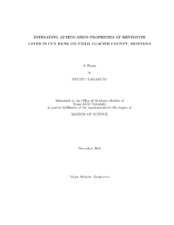| dc.contributor.advisor | Gibson, Richard L. | |
| dc.creator | Karakurt, Necdet | |
| dc.date.accessioned | 2006-04-12T16:05:43Z | |
| dc.date.available | 2006-04-12T16:05:43Z | |
| dc.date.created | 2005-12 | |
| dc.date.issued | 2006-04-12 | |
| dc.identifier.uri | https://hdl.handle.net/1969.1/3282 | |
| dc.description.abstract | Acquisition and interpretation of 3-D seismic data led DeAngelo and Hardage (2001)
to describe the channel system in the south central Cut Bank area in Glacier County,
Montana. The presence of a low velocity layer called Bentonite was also discovered
in the area with the help of well-logs. Bentonite is a volcanic ash, which lies on both
sides of the channel system and is absent within the channel. DeAngelo and Hardage
(2001) shot a vertical seismic profiling (VSP) survey at well # 54-8 to analyze the
formation structure in depth, since seismic signals around the reservoir area were
unclear in the 3-D survey.
This research attempts to estimate the attenuation properties of the Bentonite
layer in the Cut Bank oil field. VSP data is processed for velocity information and
estimation of seismic Q using the spectral ratios method (SRM). The SRM theoretically
assumes that the propagating signal is a plane seismic wave traveling vertically
from one point to another in a homogeneous model. The amplitudes at the start
and end points are known and relate to each other with the attenuation coefficient in
a frequency range. The relation between the seismic amplitudes at z distance from
each other can be expressed as a linear function of frequency after a few modifications.
SRM uses the linearity of the logarithmic ratio of the seismic amplitudes over
a frequency range. In theory, ratios plotted against a frequency range must produce
a flat line. However, in practice, the logarithmic ratios are expected to draw an approximate
line (curve), where some of the data points deviate from the origin of the
line. Thus fitting a line to the ratios curve and calculating the slope of this curve are
necessary. Slope of the curve relates to the seismic attenuation coefficient and further
to the seismic Q.
The SRM results suggest that Bentonite may have a Q value as low as 5. This
highly attenuative and thin (20 to 40 feet throughout the south central Cut Bank
Unit) layer alters seismic signals propagating through it. A thorough analysis of
the amplitude spectra suggests that seismic signals dramatically lose their energy
when they pass through Bentonite. Low energy content of the signals below the Bentonite layer highlights that the recovery of the seismic energy is less likely despite
the presence of multiples, which are known to affect the seismic signals constructively.
Therefore, separation of reflected events is a greater challenge for the thin reservoir
sand units lying underneath the Bentonite layer. Thus the Bentonite layer in the
Cut Bank oil field has to be taken seriously and data processing should be done
accordingly for better accuracy. | en |
| dc.format.extent | 2374391 bytes | en |
| dc.format.medium | electronic | en |
| dc.format.mimetype | application/pdf | |
| dc.language.iso | en_US | |
| dc.publisher | Texas A&M University | |
| dc.subject | Seismic attenuation | en |
| dc.subject | Seismic Q | en |
| dc.subject | Bentonite | en |
| dc.subject | VSP | en |
| dc.subject | attenuation analysis | en |
| dc.subject | Cut Bank oil and gas field | en |
| dc.subject | Spectral ratios method | en |
| dc.subject | Q estimation | en |
| dc.title | Estimating attenuation properties of bentonite layer in Cut Bank oil field, Glacier County, Montana | en |
| dc.type | Book | en |
| dc.type | Thesis | en |
| thesis.degree.department | Geology and Geophysics | en |
| thesis.degree.discipline | Geophysics | en |
| thesis.degree.grantor | Texas A&M University | en |
| thesis.degree.name | Master of Science | en |
| thesis.degree.level | Masters | en |
| dc.contributor.committeeMember | Dorobek, Steven L. | |
| dc.contributor.committeeMember | McVay, Duane A. | |
| dc.contributor.committeeMember | Watkins, Joel S. | |
| dc.type.genre | Electronic Thesis | en |
| dc.type.material | text | en |
| dc.format.digitalOrigin | born digital | en |


